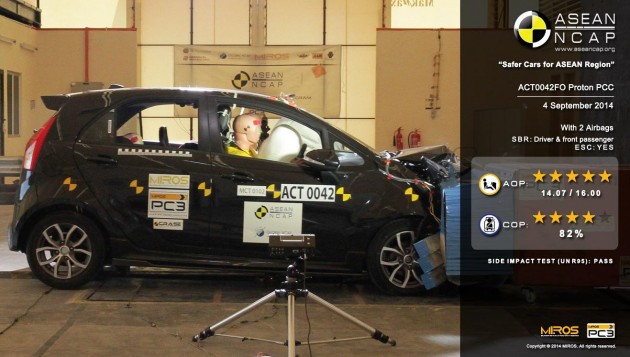The New Car Assessment Programme for South East Asian Countries (ASEAN NCAP) has released full details of its new ratings road map that will kick off in 2017, and will last all the way until 2020. The agency said that the new system was already outlined in Bandung, Indonesia last October, but this is the first time we’ve seen the comprehensive list of criteria in full.
For those who are unfamiliar with the current ratings system, each car currently subjected to the 40% frontal offset crash test at 64 km/h receives a points score (maximum of 16 points) for adult occupant protection (AOP), presented to the public in the form of a star rating (maximum five stars). The fitment of stability control and a seat belt reminder for both front seats is mandatory for a car to achieve a five-star rating.
The car’s performance in child occupant protection (COP) gets a separate “compliance score” in percentage, which is also displayed as a star rating. ASEAN NCAP also conducts a side impact test for each of the cars, but it is only used to determine if a car passes UN R95 regulations for side impact protection. A pass for this test is also a prerequisite for a three-star AOP rating.
From 2017 onwards, the scoring system will be largely identical, but the biggest change is that there will be just a single star rating for AOP and COP, as well as for safety assist systems such as stability control. This move, said ASEAN NCAP secretary-general Khairil Anwar Abu Kassim previously, was to “ensure a vehicle receives the highest star award and also provides the best protection for the child inside a car.”
Adult protection will make up 50% of the overall rating, while child protection and electronic safety nets will each contribute up to 25%. As before, the AOP score will incorporate the car’s offset frontal test performance which carries a maximum score of 16 points, but from 2017 there will also be a more comprehensive side impact test, also carry up to 16 points.
There will also now be a score of up to four points for head protection technologies (HPT) – these include curtain airbags and taller side airbags, but could also include other safety features that do not involve airbags, such as energy absorbing materials built into the pillars and roof, used on some Japanese kei cars. This score is based on the fitment rating system (FRS) – which we’ll come to later – and will bring the maximum attainable score for AOP to 36 points.
The COP assessment will also see a few changes, such as a side impact score that will be incorporated into a car’s dynamic COP assessment. Each vehicle will also be assessed for ease of child seat fitment, using a range of child seats specified by ASEAN NCAP – previously, the manufacturer supplied its preferred child seat for the agency to use in its crash tests.
The assessment of child seat-friendly features has also been revised, with the most notable addition being automatic front passenger airbag deactivation – child restraint system (CRS) specialist Yahaya Ahmad said that the agency preferred such a system over manual deactivation, as drivers could forget to switch the airbag on again when the child seat is removed.
Next is the assessment of safety assist technologies (SAT), which will make up the final 25% of a car’s safety rating. The agency will take into account the full gamut of driver assist systems instead of just stability control currently, including ABS, rear seat belt reminders, blind spot monitoring, autonomous emergency braking (AEB), forward collision warning and lane departure warning. As with HPTs, the scoring for SATs is based on the FRS, and carries a maximum of 18 points.
Blind spot monitoring is of particular interest for ASEAN NCAP, as it claims that such a system could help drivers detect motorcyclists more easily when changing lanes. This, it hopes, would ensure the safety of these motorcyclists – very important in a region where many commute on two wheels.
So, what exactly is the fitment rating system? Well, the entire workings of the system are incredibly difficult to wrap our head around – there’s even a rather complicated formula for calculating the scores of HPTs and SATs – but the basic principle is that it takes into account whether these technologies are fitted as standard or are only offered as a cost option. The former, of course, nets a higher score.
Looking to sell your car? Sell it with Carro.
















So axia is gonna score negative!
Complicated formula just to make sure Proton get 5 stars. Enough said.
So for this new rating system, the fitment of stability control is no longer mandatory for a car to achieve a five-star rating?
Based on 60% (or 10.8 over max. 15) score requirements on SAT to achieve 5-star, a car that excels in front & side impact may score top marks by having just ABS (4 marks), seatbeat reminders (6 marks) and some blind spot tech (2 marks). Yes, the FRS calculation is so confusing, its even tiered based on region.
I think the lack of stability control will still prevent any car from achieving a five-star rating, much like on the existing AOP-only system.
Currently, a car that scores top marks in AOP will still be barred from getting a five-star rating if it does not have ESP. Besides, it would be very odd indeed if a car came with a blind spot monitor, but no ESP.
Confusing…and the weightage seems particularly odd.
Its good that they put more emphasis on side protection…. but all these is moot unless they only test the lowest available spec cars.
There should be more weightage placed on active safety devices like ESC, Auto City brake, BLIS since these actually help prevent an accident or reduce the severity of the accident if unavoidable.